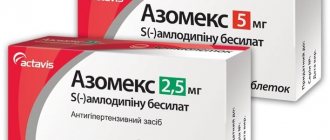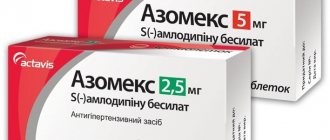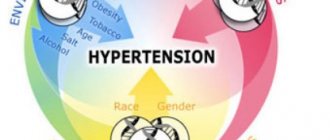Description of the dosage form
Tablets are white or white with a creamy tint, round, flat-cylindrical, with a score on one side and a bevel, almost odorless or with a weak specific odor.
pharmachologic effect
Spironolactone is a potassium-sparing diuretic, a specific antagonist of aldosterone (mineralocorticosteroid hormone of the adrenal cortex) with prolonged action. In the distal parts of the nephron, spironolactone prevents the retention of sodium and water by aldosterone and suppresses the potassium-removing effect of aldosterone, reduces the synthesis of permeases in the aldosterone-dependent area of the collecting ducts and distal tubules. By binding to aldosterone receptors, it increases the excretion of sodium, chlorine and water ions in the urine, reduces the excretion of potassium and urea ions, and reduces the acidity of urine.
The maximum effect is observed 7 hours after oral administration and lasts for at least 24 hours. The hypotensive effect of the drug is due to the presence of a diuretic effect, which is not constant: the diuretic effect appears on days 2-5 of treatment.
Pharmacokinetics
Suction and distribution
When taken orally, it is quickly and completely absorbed from the gastrointestinal tract. The maximum concentration of Cmax canrenone in the blood plasma is achieved 2-4 hours after administration. Binds to plasma proteins by approximately 98% (canrenone - 90%). Volume of distribution (Vd) - 0.05 l/kg.
After daily administration of spironolactone at a dose of 100 mg for 15 days, Cmax is 80 ng/ml, the time to reach Cmax after the next morning dose is 2-6 hours.
Spironolactone penetrates poorly into organs and tissues, while itself and its metabolites penetrate the placental barrier, and canrenone passes into breast milk.
Metabolism
Spironolactone is converted into active metabolites: a metabolite containing sulfur (80%) and partly canrenone (20%).
Removal
Excreted by the kidneys: 50% - in the form of metabolites, 10% - unchanged and partially through the intestines. The half-life (T1/2) of spironolactone is 13-24 hours, of active metabolites - up to 15 hours. The elimination of canrenone (mainly by the kidneys) is two-phase, T1/2 in the first phase is 2-3 hours, in the second - 12-96 hours.
Pharmacokinetics in selected patient groups
In liver cirrhosis and heart failure, the duration of T1/2 increases without signs of cumulation, the likelihood of which is higher in chronic renal failure and hyperkalemia.
Veroshpiron tablets: main characteristics
"Veroshpiron" refers to diuretic drugs; its effects are an antagonist of the adrenal hormone aldosterone. Available in the form of capsules and tablets of identical composition.
The active ingredient is spironolactone. Each tablet contains 25 mg, and capsules contain dosages of 50 mg and 100 mg. Spironolactone stimulates water excretion, reduces potassium loss and the formation of permease enzymes. The most pronounced effect occurs 7 hours after taking the drug, it continues for 24 hours.
Due to regular exposure to spironolactone, a decrease in blood pressure is observed, which is associated with a diuretic effect. A decrease in blood pressure is observed 2-5 weeks after the start of therapy.
The medicine is sold in pharmacies only with a prescription. It is necessary to agree with the doctor, who determines the duration of the course and dosage. The drug is stored at room temperature (maximum 30 degrees).
Indications for use of Veroshpiron
- Essential hypertension (as part of combination therapy);
- edema syndrome in chronic heart failure (can be used in monotherapy and in combination with standard therapy);
- conditions in which secondary hyperaldosteronism may be detected, including cirrhosis of the liver accompanied by ascites and/or edema, nephrotic syndrome, as well as other conditions accompanied by edema;
- hypokalemia/hypomagnesemia (as an adjuvant for its prevention during treatment with diuretics and when it is impossible to use other methods of correcting potassium levels);
- primary hyperaldosteronism (Conn's syndrome) - for a short preoperative course of treatment;
- to establish the diagnosis of primary hyperaldosteronism.
Contraindications to the use of Veroshpiron
- Hypersensitivity to any of the components of the drug;
- Addison's disease;
- hyperkalemia;
- hyponatremia;
- severe renal failure (creatinine clearance less than 10 ml/min);
- anuria;
- pregnancy;
- lactation period (breastfeeding);
- children under 3 years of age (for solid dosage form);
- lactase deficiency, lactose intolerance, glucose-galactose malabsorption syndrome (since the drug contains lactose monohydrate).
With caution: hypercalcemia, metabolic acidosis, AV block (hyperkalemia enhances it); diabetes mellitus (with confirmed or suspected chronic renal failure); diabetic nephropathy; surgical interventions during anesthesia; taking medications that cause gynecomastia; local and general anesthesia; elderly age; menstrual irregularities, enlarged mammary glands; liver failure, liver cirrhosis.
special instructions
Veroshpiron is prescribed in gynecology to reduce androgen levels in women with PCOS ( polycystic ovary syndrome ). The drug can cause bleeding and disrupt the menstrual cycle.
Veroshpiron is often recommended to be taken together with contraceptives in order to normalize the menstrual cycle and reduce hirsutism .
Recipe in Latin:
Rp.: Verospironi 0.025 D. td N 20 in tabul. S.
Side effects
From the gastrointestinal tract: nausea, vomiting, diarrhea, ulceration and bleeding from the gastrointestinal tract, gastritis, intestinal colic, abdominal pain, constipation.
From the liver: impaired liver function.
From the nervous system: ataxia, lethargy, dizziness, headache, drowsiness, lethargy, confusion, muscle spasm.
From the blood and lymphatic system: agranulocytosis, thrombocytopenia, megaloblastosis.
From laboratory parameters: hyperuricemia, hypercreatininemia, increased urea concentration, disturbance of water and electrolyte balance (hyperkalemia, hyponatremia) and acid-base status (metabolic hyperchloremic acidosis or alkalosis).
From the endocrine system: deepening of the voice, in men - gynecomastia (the likelihood of development depends on the dose, duration of treatment and is usually reversible, and disappears after discontinuation of the drug, and only in rare cases the mammary gland remains slightly enlarged), decreased potency and erection; in women - menstrual irregularities, dysmenorrhea, amenorrhea, metrorrhagia during menopause, hirsutism, pain in the mammary glands, breast carcinoma (no connection with the drug has been established).
Allergic reactions: urticaria, maculopapular and erythematous rash, drug fever, pruritus, eosinophilia, Stevens-Johnson syndrome, toxic epidermal necrolysis.
From the skin and subcutaneous tissues: alopecia, hypertrichosis.
From the kidneys and urinary tract: acute renal failure.
Musculoskeletal and connective tissue disorders: calf muscle cramps.
From the respiratory system: shortness of breath.
If any of the above adverse reactions worsen or other adverse events not listed in the instructions occur, the patient should inform the doctor.
Side effects of the drug Veroshpiron
Hyperkalemia and hyponatremia; with long-term use of Veroshpiron, gynecomastia and erectile dysfunction in men, menstrual irregularities and enlarged mammary glands in women are possible; It is possible to change the timbre of the voice in both men and women. Dysfunction of the digestive system may also occur (vomiting, diarrhea, gastrointestinal bleeding, gastric and duodenal ulcers, gastritis); disorders of the central nervous system (lethargy, ataxia, headache), skin reactions (maculopapular or erythematous skin rash), agranulocytosis. Side effects are usually reversible and disappear after discontinuation of Veroshpiron.
Drug interactions
Reduces the effect of anticoagulants, indirect anticoagulants (heparin, coumarin derivatives, indanedione) and the toxicity of cardiac glycosides (since normalization of potassium content in the blood prevents the development of toxicity).
Enhances the metabolism of phenazone (antipyrine).
Reduces the sensitivity of blood vessels to norepinephrine (care is required when performing anesthesia), increases T1/2 of digoxin - digoxin intoxication is possible.
Increases the toxic effect of lithium due to decreased clearance.
Possibly enhances the effect of non-depolarizing muscle relaxants (for example, tubocurarine).
Accelerates the metabolism and excretion of carbenoxolone.
Carbenoxolone promotes sodium retention by spironolactone.
GCS and diuretics (thiazides and thiazide-like, furosemide, ethacrynic acid) enhance and accelerate the diuretic and natriuretic effects.
Enhances the effect of diuretic and antihypertensive drugs.
NSAIDs reduce the diuretic and natriuretic effects, increasing the risk of hyperkalemia.
Alcohol (ethanol), barbiturates, and narcotic substances increase orthostatic hypotension.
GCS enhance the diuretic and natriuretic effect in hypoalbuminemia and/or hyponatremia.
The risk of developing hyperkalemia increases when taken with potassium preparations, potassium supplements and potassium-sparing diuretics, ACE inhibitors (acidosis), angiotensin II receptor antagonists, aldosterone blockers, indomethacin, cyclosporine.
Salicylates and indomethacin reduce the diuretic effect of spironolactone.
Ammonium chloride and cholestyramine contribute to the development of hyperkalemic metabolic acidosis.
Fludrocortisone causes a paradoxical increase in tubular secretion of potassium.
Spironolactone reduces the effect of mitotane.
Enhances the effects of triptorelin, buserelin, gonadorelin.
Dosage of Veroshpiron
Inside.
Essential hypertension
The daily dose for adults is usually 50-100 mg once and can be increased to 200 mg, and the dose should be increased gradually, once every 2 weeks. To achieve an adequate response to therapy, the drug must be taken for at least 2 weeks. If necessary, adjust the dose.
Idiopathic hyperaldosteronism
Prescribed at a dose of 100-400 mg/day.
Severe hyperaldosteronism and hypokalemia
Prescribe 300 mg/day (maximum 400 mg/day) in 2-3 doses; as the condition improves, the dose is gradually reduced to 25 mg/day.
Hypokalemia and/or hypomagnesemia
For hypokalemia and/or hypomagnesemia caused by diuretic therapy, the drug is prescribed at a dose of 25-100 mg/day, once or in several doses. The maximum daily dose is 400 mg if oral potassium supplements or other methods of replenishing the deficiency are ineffective.
Diagnosis and treatment of primary hyperaldosteronism
As a diagnostic agent for a short diagnostic test: for 4 days, 400 mg/day, divided into several doses per day. If the concentration of potassium in the blood increases while taking the drug and decreases after its discontinuation, the presence of primary hyperaldosteronism can be assumed.
For a long-term diagnostic test: at the same dose for 3-4 weeks. When correction of hypokalemia and arterial hypertension is achieved, the presence of primary hyperaldosteronism can be assumed.
Short course of preoperative therapy for primary hyperaldosteronism
After the diagnosis of hyperaldosteronism has been established using more accurate diagnostic methods, Verospilactone should be taken at a dose of 100-400 mg/day, divided into 1-4 doses during the entire period of preparation for surgery. If surgery is not indicated, then the drug Verospilactone is used for long-term maintenance therapy, using the lowest effective dose, which is selected individually for each patient.
Edema due to nephrotic syndrome
The daily dose for adults is usually 100-200 mg/day. No effect of spironolactone on the underlying pathological process has been identified, and therefore the use of this drug is recommended only in cases where other types of therapy are ineffective.
Edema syndrome due to chronic heart failure
Daily, for 5 days, 100-200 mg/day in 2-3 divided doses, in combination with a loop or thiazide diuretic. Depending on the effect, the daily dose is reduced to 25 mg. The maintenance dose is selected individually. Maximum dose 200 mg/day.
Edema due to liver cirrhosis
If the ratio of sodium and potassium ions (Na+/K+) in the urine exceeds 1.0, then the daily dose for adults is usually 100 mg. If the ratio is less than 1.0, then the daily dose for adults is usually 200-400 mg. The maintenance dose is selected individually.
Edema in children
The initial dose in children over 3 years of age is 1-3.3 mg/kg body weight or 30-90 mg/m2/day in 1-4 doses. After 5 days, the dose is adjusted and, if necessary, increased by 3 times compared to the original.
Veroshpiron price, where to buy
The price of Veroshpiron in tablets is about 100 rubles for 20 pieces.
50 mg capsules can be purchased for an average of 180 rubles per 30 pieces. Capsules 100 mg - 300 rubles for 30 pieces.
- Online pharmacies in RussiaRussia
- Online pharmacies in UkraineUkraine
- Online pharmacies in KazakhstanKazakhstan
ZdravCity
- Veroshpiron capsules 100 mg 30 pcs. JSC "Gedeon Richter-RUS"
256 rub. order - Veroshpiron tab. 25 mg 20 pcs. JSC "Gedeon Richter-RUS" RU
87 RUR order
- Veroshpiron capsules 50 mg 30 pcs. JSC "Gedeon Richter-RUS"
RUB 187 order
Pharmacy Dialogue
- Veroshpiron capsules 50 mg No. 30 Gedeon-Richter
185 rub. order
- Veroshpiron (tab. 25 mg No. 20)Gedeon-Richter-RUS - JSC
90 rub. order
- Veroshpiron (caps. 100 mg No. 30)Gedeon-Richter-RUS - JSC
RUB 276 order
- Veroshpiron (tab. 25 mg No. 20) Gedeon-Richter-RUS ZAO
92 rub. order
- Veroshpiron (caps. 50 mg No. 30)Gedeon-Richter-RUS - JSC
190 rub. order
show more
Pharmacy24
- Veroshpiron 50 mg No. 30 capsules VAT "Gedeon Richter", Ugorshchina
97 UAH. order - Veroshpiron 25 mg N20 tablets AT"Gedeon Richter"/TOV "Gedeon Richter Poland", Ugorshchina/Poland
34 UAH order
- Veroshpiron 100 mg No. 30 capsules VAT "Gedeon Richter", Ugorshchina
135 UAH order
PaniPharmacy
- Veroshpiron tablets Veroshpiron tablets 25 mg No. 20 Hungary, Gedeon Richter
34 UAH order
- Veroshpiron capsule Veroshpiron caps. 100 mg No. 30 Hungary, Gedeon Richter
138 UAH order
- Veroshpiron capsule Veroshpiron caps. 50 mg No. 30 Hungary, Gedeon Richter
100 UAH order
show more
Overdose
Symptoms: nausea, vomiting, dizziness, diarrhea, skin rash, hyperkalemia (paresthesia, muscle weakness, arrhythmias), hyponatremia (dry mouth, thirst, drowsiness), hypercalcemia, dehydration, increased urea concentration.
Treatment: gastric lavage, symptomatic treatment of dehydration and arterial hypotension. In case of hyperkalemia, it is necessary to normalize the water-electrolyte balance with the help of potassium-removing diuretics, rapid parenteral administration of a 5-20% dextrose (glucose) solution with insulin at the rate of 0.25-0.5 units per 1 g of dextrose (glucose); can be re-entered if necessary. In severe cases, hemodialysis is performed.








